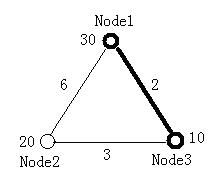Minimal Ratio Tree
Time Limit: 2000/1000 MS (Java/Others) Memory Limit: 32768/32768 K (Java/Others)Total Submission(s): 3345 Accepted Submission(s): 1019
Problem Description
For a tree, which nodes and edges are all weighted, the ratio of it is calculated according to the following equation.

Given a complete graph of n nodes with all nodes and edges weighted, your task is to find a tree, which is a sub-graph of the original graph, with m nodes and whose ratio is the smallest among all the trees of m nodes in the graph.

Given a complete graph of n nodes with all nodes and edges weighted, your task is to find a tree, which is a sub-graph of the original graph, with m nodes and whose ratio is the smallest among all the trees of m nodes in the graph.
Input
Input contains multiple test cases. The first line of each test case contains two integers n (2<=n<=15) and m (2<=m<=n), which stands for the number of nodes in the graph and the number of nodes in the minimal ratio tree. Two zeros end the input. The next line
contains n numbers which stand for the weight of each node. The following n lines contain a diagonally symmetrical n×n connectivity matrix with each element shows the weight of the edge connecting one node with another. Of course, the diagonal will be all
0, since there is no edge connecting a node with itself.
All the weights of both nodes and edges (except for the ones on the diagonal of the matrix) are integers and in the range of [1, 100].
The figure below illustrates the first test case in sample input. Node 1 and Node 3 form the minimal ratio tree.

All the weights of both nodes and edges (except for the ones on the diagonal of the matrix) are integers and in the range of [1, 100].
The figure below illustrates the first test case in sample input. Node 1 and Node 3 form the minimal ratio tree.

Output
For each test case output one line contains a sequence of the m nodes which constructs the minimal ratio tree. Nodes should be arranged in ascending order. If there are several such sequences, pick the one which has the smallest node number; if there's a tie,
look at the second smallest node number, etc. Please note that the nodes are numbered from 1 .
Sample Input
3 2 30 20 10 0 6 2 6 0 3 2 3 0 2 2 1 1 0 2 2 0 0 0
Sample Output
1 3 1 2
给出n个点的权值和这n个点之间的边的权值。从这n个点之中选出m个点使得这m个点的权值最大,这m个点的生成树中边的权值最小。即Ratio最小。依照升序输出这m个点。
解题思路:
首先n的范围是[2,15],所以能够用dfs搜索使得Ratio最小的点。那么思路基本清晰:首先dfs,搜索全部的点选与不选所得到的最大的Ratio。假设当前状态下得到的Ratio比之前得到的Ratio要小,那么把当前状态的vis数组更新的答案ans数组中。
最后从1到n扫描ans数组就可以保证答案是升序。
參考代码:
#include<stack>
#include<queue>
#include<cmath>
#include<cstdio>
#include<cstring>
#include<iostream>
#include<algorithm>
#pragma commment(linker,"/STACK: 102400000 102400000")
using namespace std;
const double eps=1e-6;
const int INF=0x3f3f3f3f;
const int MAXN=20;
int n,m,mincost[MAXN],node[MAXN],edge[MAXN][MAXN];
bool vis[MAXN],used[MAXN],ans[MAXN];
double temp;
double prim()
{
memset(mincost,0,sizeof(mincost));
memset(used,false,sizeof(used));
int s;
for(int i=1; i<=n; i++)
if(vis[i])
{
s=i;
break;
}
for(int i=1; i<=n; i++)
{
mincost[i]=edge[s][i];
used[i]=false;
}
used[s]=true;
int res=0;
int nodevalue=node[s];
for(int j=1; j<n; j++)
{
int v=-1;
for(int i=1; i<=n; i++)
if(vis[i]&&!used[i]&&(v==-1||mincost[v]>mincost[i]))//vis[i]表示第i个点有没有被选中
v=i;
res+=mincost[v];
nodevalue+=node[v];
used[v]=true;
for(int i=1; i<=n; i++)
if(vis[i]&&!used[i]&&mincost[i]>edge[v][i])
mincost[i]=edge[v][i];
}
return (res+0.0)/nodevalue;
}
void dfs(int pos,int num)
{
if(num>m)
return ;
if(pos==n+1)
{
if(num!=m)
return ;
double tans=prim();
if(tans<temp)
{
temp=tans;
memcpy(ans,vis,sizeof(ans));
}
return ;
}
vis[pos]=true;//选择当前点
dfs(pos+1,num+1);
vis[pos]=false;//不选择当前点,消除标记
dfs(pos+1,num);
}
int main()
{
#ifndef ONLINE_JUDGE
freopen("in.txt","r",stdin);
#endif // ONLINE_JUDGE
while(scanf("%d%d",&n,&m))
{
if(n==0&&m==0)
break;
for(int i=1; i<=n; i++)
scanf("%d",&node[i]);
for(int i=1; i<=n; i++)
for(int j=1; j<=n; j++)
scanf("%d",&edge[i][j]);
temp=INF;
dfs(1,0);
bool flag=false;
for(int i=1; i<=n; i++)
{
if(ans[i])
{
if(flag)
printf(" ");
else
flag=true;
printf("%d",i);
}
}
printf("
");
}
return 0;
}